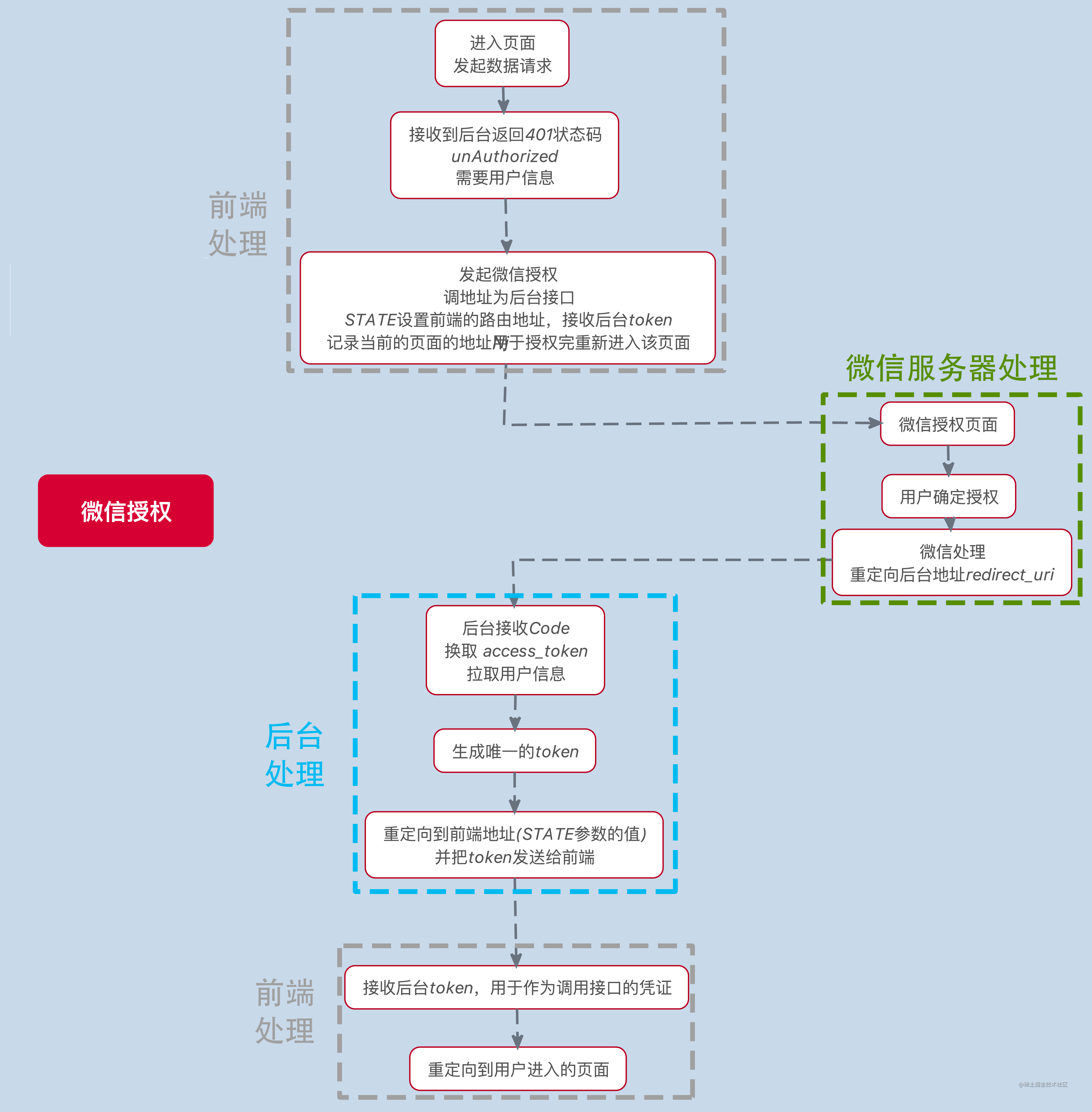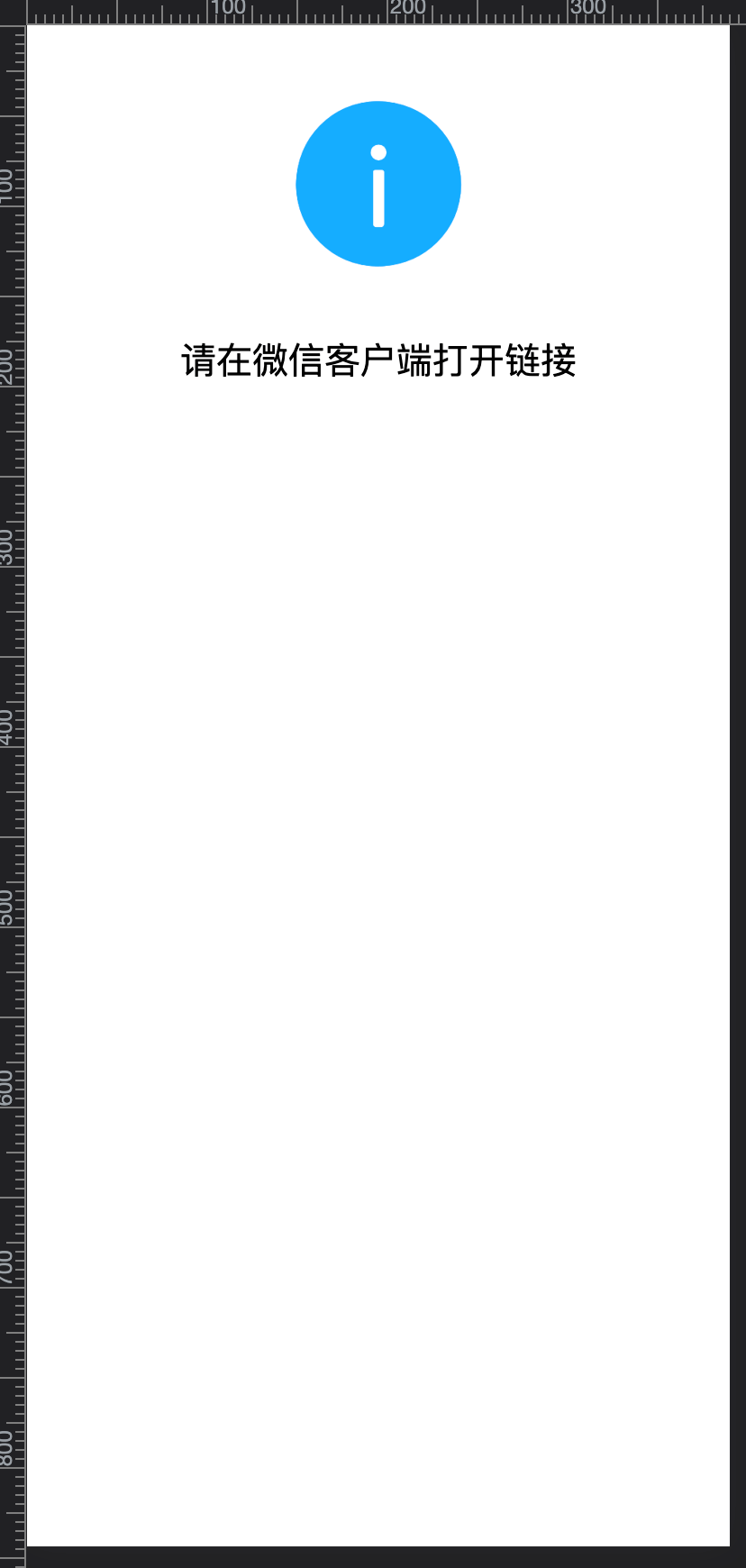微信网页授权开发指南
开发背景
一般用于分享到微信环境(微信应用内打开,比如单聊、群聊、朋友圈等路径进入的链接)的网页需要获取当前访问用户信息,并处理相应的业务逻辑功能及跟踪埋点信息上报等操作
开发前提
- 需要授权的应用是一个网页应用(一般是H5应用),类似微信公众号开发;
- 需要微信公众平台账号,也就是 appId,需要官方微信公众平台配置信息;
确认具体需求:
- 只需要微信公众号授权即可,无需借助微信能力;
- 需要访问链接用户进行微信公众号授权及调用微信能力,比如分享好友、分享朋友圈等权限;
授权流程

授权链接
javascript
https://open.weixin.qq.com/connect/oauth2/authorize?appid=APPID&redirect_uri=REDIRECT_URL&response_type=code&scope=snsapi_userinfo&state=STATE#wechat_redirect| 字段 | 是否必填 | 含义 | 说明 |
|---|---|---|---|
| APPID | 是 | 公众号唯一的APPID | |
| REDIRECT_URL | 是 | 回调地址,需要进行urlEncode处理 | 授权完后微信将会跳到该地址,如无特殊说明,该回调地址是后台接口,负责接收code,code以?code=123456的参数形式接在回调地址后面 |
| STATE | 否 | 重定向后会带上state参数,开发者可以填写a-zA-Z0-9的参数值,最多128字节 | 一般可以是前端告诉后台跳转授权前的页面地址,让后台获取code之后重定向到该地址,并且在该地址后带上token数据 |
| response_type | 是 | 返回类型,此处填写code | |
| scope | 是 | 应用授权作用域:snsapi_base (不弹出授权页面,直接跳转,只能获取用户openid),snsapi_userinfo (弹出授权页面,可通过openid拿到昵称、性别、所在地。并且,即使在未关注的情况下,只要用户授权,也能获取其信息) | |
| #wechat_redirect | 是 | 无论直接打开还是做页面302重定向时候,必须带此参数 |
开发规范
开发注意事项
- 是否限制链接打开路径来源: 当非微信平台打开链接时,使用微信官方提示:

- 是否需要占位符提示语控制
编码规范
- 授权方法
JavaScript
import { getStore, setStore } from '@/utils/util'
const qs = require('qs')
// 应用授权作用域,snsapi_base (不弹出授权页面,直接跳转,只能获取用户openid),snsapi_userinfo (弹出授权页面,可通过openid拿到昵称、性别、所在地。并且,即使在未关注的情况下,只要用户授权,也能获取其信息)
const SCOPES = ['snsapi_base', 'snsapi_userinfo']
/**
* @param { string } appid 公众号的唯一标识
* @param { string } redirect_uri 授权后重定向的回调链接地址, 请使用 urlEncode 对链接进行处理
* @param { string } scope 应用授权作用域,snsapi_base (不弹出授权页面,直接跳转,只能获取用户openid),snsapi_userinfo (弹出授权页面,可通过openid拿到昵称、性别、所在地。并且, 即使在未关注的情况下,只要用户授权,也能获取其信息 )
* @param { string } state 非必须 重定向后会带上state参数,开发者可以填写a-zA-Z0-9的参数值,最多128字节
* @param #wechat_redirect 无论直接打开还是做页面302重定向时候,必须带此参数
*/
class WechatAuthPlugin {
constructor() {
this.appid = null
this.redirect_uri = null
this._scope = SCOPES[0] // 授权类型,默认使用静默授权
this._code = null
this._redirect_uri = null
}
// 设置随机state参数
static makeState() {
return (
Math.random()
.toString(36)
.substring(2, 15) +
Math.random()
.toString(36)
.substring(2, 15)
)
}
// 公众号的唯一标识
setAppId(appid) {
this.appid = appid
}
/**
* @description 设置授权后重定向的回调链接地址, 使用 urlEncode 对链接进行处理
* @param { * } redirect_uri 访问的redirect_uri,非必须,不传自动获取当前url
*/
set redirect_uri(redirect_uri) {
this._redirect_uri = encodeURIComponent(redirect_uri)
}
// 获取redirect_uri
get redirect_uri() {
return this._redirect_uri
}
/**
* @description 设置授权状态
* @param { * } idx 0 - 静默授权,1 - 非静默授权
*/
set scope(idx) {
this._scope = SCOPES[idx]
}
// 获取scope
get scope() {
return this._scope
}
// 获取缓存中state,否则返回默认值'STATE'
get state() {
return ['null', 'undefined', '', null, undefined].includes(getStore('wechat_auth:state')) ? 'STATE' : getStore('wechat_auth:state')
}
// state存储在缓存中
set state(state) {
setStore('wechat_auth:state', state)
}
// 设置state值
setState(value) {
this.state = value || WechatAuthPlugin.makeState()
}
/**
* @description 获取引导关注着打开访问链接
*/
get authUrl() {
if (this.appid === null) {
throw new Error('appid must not be null')
}
if (this.redirect_uri === null) {
throw new Error('redirect uri must not be null')
}
return `https://open.weixin.qq.com/connect/oauth2/authorize?appid=${this.appid}&redirect_uri=${this.redirect_uri}&response_type=code&scope=${this.scope}&state=${this.state}#wechat_redirect`
}
// 用户同意授权,页面将跳转至 redirect_uri/?code=CODE&state=STATE,获取code参数
returnFromWechat(redirect_uri) {
const baseWithSearch = redirect_uri.split('#')[0]
let parsedUrl = ''
// 本地环境
if (process.env.NODE_ENV === 'development') {
parsedUrl = qs.parse(redirect_uri.split('?')[1])
this.state = null
this._code = parsedUrl.code
} else {
parsedUrl = qs.parse(baseWithSearch.split('?')[1])
if (parsedUrl.code) {
this._code = parsedUrl.code
}
}
}
get code() {
if (this._code === null) {
throw new Error('Not get the code from wechat server!')
}
const code = this._code
this._code = null
return code
}
/**
* 处理url链接
* @returns {string}
*/
processUrl() {
const url = window.location.href
// 解决多次登录url添加重复的code与state问题
const urlParams = qs.parse(url.split('?')[1])
let redirectUrl = url
if (urlParams.code && urlParams.state) {
delete urlParams.code
delete urlParams.state
const query = qs.stringify(urlParams)
if (query.length) {
redirectUrl = `${url.split('?')[0]}?${query}`
} else {
redirectUrl = `${url.split('?')[0]}`
}
}
return redirectUrl
}
}
const wechatAuthPlugin = new WechatAuthPlugin()
export default wechatAuthPlugin2.调用方法:
JavaScript
import router from '@/router'
import wechatAuth from '@/utils/wechatAuth'
import { getStore, setStore } from '@/utils/util'
import { CONFIG_STORAGE } from '@/utils/configs'
import API from '@/api'
// 设置APPID
const WX_APPID = 'xxx'
wechatAuth.setAppId(WX_APPID)
router.beforeEach(async (to, from, next) => {
// 授权态 0为未授权 1为授权返回code 2为使用code获取openid成功
let authStatus = getStore(CONFIG_STORAGE.AuthStatusKey) // 微信授权状态
authStatus = authStatus === null || undefined ? 0 : authStatus
switch (Number(authStatus)) {
case 0:
// 获取h5页面地址赋值给redirect_uri
wechatAuth.redirect_uri = wechatAuth.processUrl()
// 更改授权状态为1
setStore(CONFIG_STORAGE.AuthStatusKey, 1)
// 跳转到获取code访问链接
window.location.href = wechatAuth.authUrl
break
case 1: {
// 获取code值
wechatAuth.returnFromWechat(window.location.href)
const code = wechatAuth.code
// 判断code是否存在
if (!code) {
setStore(CONFIG_STORAGE.AuthStatusKey, 0)
}
// 使用cod换取eopenId
API.getWxTokenApi({code})
.then(res => {
if (res.code === '0') {
// 获取openId之后存储,并将状态更改为2
setStore(CONFIG_STORAGE.openId, res.data)
setStore(CONFIG_STORAGE.AuthStatusKey, 2)
// 对路由重定向
window.location.href = `${window.location.origin}${window.location.pathname}/${window.location.hash}`
} else {
setStore(CONFIG_STORAGE.AuthStatusKey, 0)
}
})
.catch(err => {
console.log(err)
setStore(CONFIG_STORAGE.AuthStatusKey, 0)
})
break
}
case 2:
// 若openId缺失,状态置为0,去首页重新授权
if (!getStore(CONFIG_STORAGE.openId)) {
setStore(CONFIG_STORAGE.AuthStatusKey, 0)
next('/')
} else {
next()
}
break
default:
break
}
})